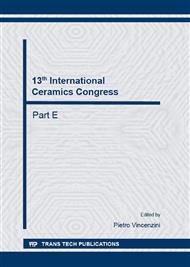p.54
p.64
p.70
p.79
p.82
p.88
p.94
p.100
p.108
Lightweight Bi-Layered Ceramic Tiles for Novel Applications
Abstract:
The excellent properties of porcelain stoneware tiles make them ideal materials for floor covering. However, their high density limits their use in novel applications, where low weight and low thermal conductivity are required. In this work, the production of lightweight bi-layered ceramics, with suitable mechanical resistance and low thermal conductivity in comparison with commercial tiles, is reported. The weight and thermal conductivity reduction was achieved by means of porogen incorporation. The possibility of using polypropylene (PP) as a pore forming agent was evaluated. PP completely burns out at relatively low temperatures with no emission of hazardous gases, and does not induce defects in the ceramic pieces. Results demonstrate that porosity (pore volume, number and area) can be easily controlled by adjusting the porogen amount (5-15 wt.%). The reduction in weight (7.5%) and thermal conductivity (up to five times) in comparison to commercial stoneware tiles might extend their use to novel applications.
Info:
Periodical:
Pages:
82-87
Citation:
Online since:
October 2014
Authors:
Price:
Сopyright:
© 2014 Trans Tech Publications Ltd. All Rights Reserved
Share:
Citation:


